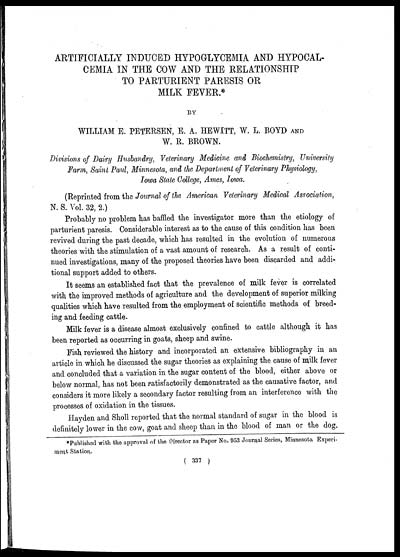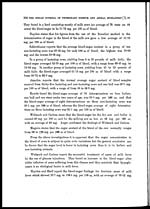Medicine - Veterinary > Veterinary colleges and laboratories > Indian journal of veterinary science and animal husbandry > Volume 1, 1931 > Part IV (December 1931) > Artificially induced hypoglycemia and hypocalcemia in the cow and the relationship to parturient paresis or milk fever (with one figure)
(384) Page 337
Download files
Individual page:
Thumbnail gallery: Grid view | List view

ARTIFICIALLY INDUCED HYPOGLYCEMIA AND HYPOCAL-
CEMIA IN THE COW AND THE RELATIONSHIP
TO PARTURIENT PARESIS OR
MILK FEVER .*
BY
WILLIAM E. PETERSEN, E. A. HEWITT, W. L. BOYD AND
W. R. BROWN.
Divisions of Dairy Husbandry, Veterinary Medicine and Biochemistry, University
Farm, Saint Paul, Minnesota, and the Department of Veterinary Physiology,
Iowa Stale College, Ames, Iowa.
(Reprinted from the Journal of the American Veterinary Medical Association,
N. S. Vol. 32, 2.)
Probably no problem has baffled the investigator more than the etiology of
parturient paresis. Considerable interest as to the cause of this condition has been
revived during the past decade, which has resulted in the evolution of numerous
theories with the stimulation of a vast amount of research. As a result of conti-
nued investigations, many of the proposed theories have been discarded and addi-
tional support added to others.
It seems an established fact that the prevalence of milk fever is correlated
with the improved methods of agriculture and the development of superior milking
qualities which have resulted from the employment of scientific methods of breed-
ing and feeding cattle.
Milk fever is a disease almost exclusively confined to cattle although it has
been reported as occurring in goats, sheep and swine.
Fish reviewed the history and incorporated an extensive bibliography in an
article in which he discussed the sugar theories as explaining the cause of milk fever
and concluded that a variation in the sugar content of the blood, either above or
below normal, has not been patisfactorily demonstrated as the causative factor, and
considers it more likely a secondary factor resulting from an interference with the
processes of oxidation in the tissues.
Hayden and Sholl reported that the normal standard of sugar in the blood is
definitely lower in the cow, goat and sheep than in the blood of man or the dog.
*Published with the approval of the Director as Paper No. 953 Journal Series, Minnesota Experi-
ment Station.
( 337 )
Set display mode to: Large image | Zoom image | Transcription
Images and transcriptions on this page, including medium image downloads, may be used under the Creative Commons Attribution 4.0 International Licence unless otherwise stated. ![]()
| Permanent URL | https://digital.nls.uk/75226947 |
|---|
| Description | Covers articles from 1931. |
|---|




